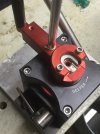Bryan Blake of F-Class Products turned in the second highest score to ever be fired in a sanctioned F-Class match recently. In a 5mph+ condition... he scored a 200-19X at 1000yds! Folks, the X-ring on a 1000yd F-class target is 5" in diameter... and his one shot that was outside the X-ring missed it by about 1/32 of an inch! Bryan credited our CPS as one of the pieces of equipment which were significant in his performance. His AutoDOD is another. (which I can't wait to get!)
Ask Jason Wolf what he thinks about our CPS. Jason has absolutely dominated IBS 600yd benchrest for the last two years. I don't think he'd be using our CPS if there was any reason it didn't prime cases correctly.
Jason Wolf
2020 IBS 600YD National Champion
2 gun overall 1st place, light gun group 1st, light gun score 1st, light gun overall 1st, heavy gun score 1st, heavy gun group 2nd, heavy gun overall 1st,
2019 IBS 600yd National Champion
HG Overall winner, HG score winner, LG overall winner, LG score winner
I would argue that there is not a technical, fact-based argument against the way our CPS seats primers. Certainly not one that even the best shooter in the world will be able to identify when shooting... as we have several record-setting and international champion level shooters running the CPS to load their competition ammo. Some of the most winning F-class and benchrest competitors of recent years are using the CPS to prime their cases. Some literally kept it a secret for several years because they were so confident in the edge it was giving them. (
Their words, not mine.)
Yet I have no illusions of the CPS being right for everyone. However, having experience with the device in question before anchoring into any opinions, well that's what separates truth from theory. You've either used a CPS... or you haven't. If you haven't, then you truly do not understand what you are missing. If people want to refuse to use one, and simultaneously make claims against it... I guess I can't stop them. It seems a very strange behavior that people exhibit... I've always found it odd! I tend to only talk about things which I've used extensively.
Taken a few steps further, we've discovered the distance from the bottom of the primer pocket isn't necessarily the most important thing in placing primers. It just so happens to be how most folks measure, and that's OK. It's a convenient measurement and it can be an important one. There has to be some metric. The most important thing is the primers distance from the static powder column, and also from the priming pin/ignition system. Hence why when shooters follow my recommendation of performing a primer seating depth test, much in the same way as you'd perform a bullet seating depth test... you can discover nodes. These nodes have demonstrated to be dependent on the priming tools ability to place primers as perfectly as possible in relation to the rest of the batch, rather than the individual case variance. That means, so long as your rim thicknesses are on tolerance, then so too will your ignition timing uniformity. Most rim thicknesses are quite good... and even so, its the distance from the top of the rim to the bottom of the pocket that matters when using our tool... and this metric is quite reliable in quality brass.
3rd party testers have reported being able to shoot the difference between half a thousand (5 ten thousandths) in primer depth. I'm skeptical, but as one of these shooters holds a national title... who am I to argue. The CPS can effectively run between clicks and achieve that 5 ten thousandths movement reliably. Regardless, the technical merits of being able to seat primers to that degree of precision and uniformity, and be able to do it at a rate of over 1000 cases per hour comfortably puts the CPS in a class all by itself.
It would take an article 20 pages long to properly disclose the testing, feedback, testimonials, and other efforts various companies have put into the vetting of the CPS. The FBI ballistic research labs all across this country evaluated every single priming tool on the market and ended up ordering nearly a dozen CPS's because "it is the only tool that can do what we need it to do, as repeatable as we need it to be." Even customers that do not need the precision, get it by proxy when going for what they really want: SPEED! Our tool can prime nearly as fast as a progressive press and do it without undue strain on the person running it. Many people with disabilities rely on the CPS to be able to load.
I truly loathe self promotion, because it's virtually impossible for me to tell you the truth of things without it sounding unbelievable. So the only request I have is that you talk with people that
actually own or have owned a CPS before making your purchasing decision. I hear from customers every single week that tell me they are blown away by the quality, precision, and speed of the CPS. Don't take my word for it... ask them yourselves. That said, if anyone wants to have a high level technical discussion regarding the mechanical aspects of this tool, or the most cutting edge primer placement testing techniques being used today... you can give me a call anytime at 605-554-1911. If no one is available just leave a message and I'll get back to you asap.
I'll get out of the way now and leave folks peacefully to their postings.






